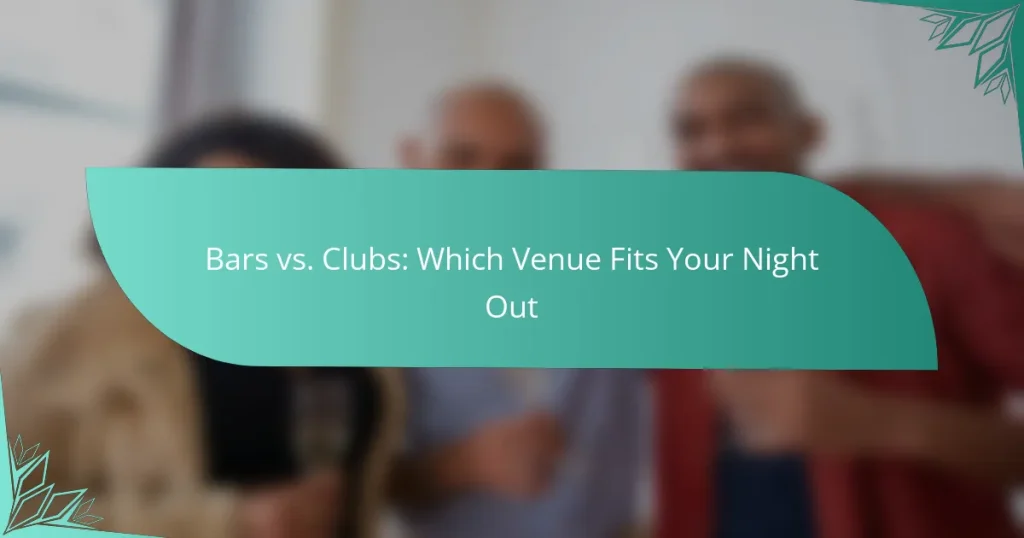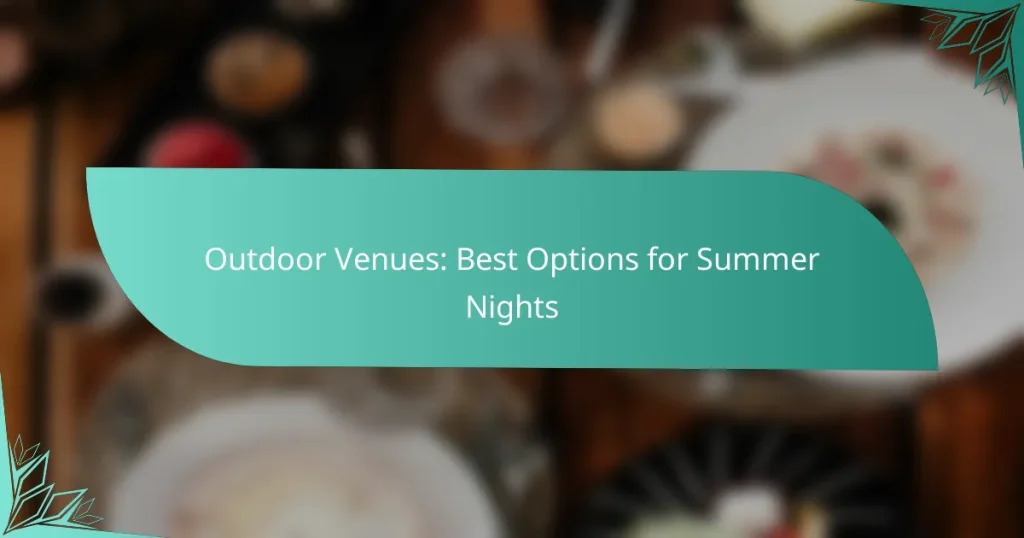New York City offers a vibrant and diverse nightlife scene, featuring a variety of venues that cater to different tastes and preferences. From lively bars and energetic clubs to intimate lounges and engaging live music spaces, each venue provides a unique atmosphere that enhances the overall experience for patrons.
Nightlife Venues: Urban vs. Suburban Comparisons
Bars vs. Clubs: Which Venue Fits Your Night Out
Outdoor Venues: Best Options for Summer Nights
Themed Venues: Choosing Based on Your Interests
What types of nightlife venues are popular in New York City?
New York City boasts a diverse array of nightlife venues, each offering unique experiences. Popular options include bars, clubs, lounges, live music venues, and comedy clubs, catering to various tastes and preferences.
Bars
Bars in New York City range from casual dive bars to upscale cocktail lounges. Many bars offer happy hour specials, making them ideal for after-work gatherings. Popular neighborhoods for bar hopping include the Lower East Side, Williamsburg, and Hell’s Kitchen.
When choosing a bar, consider the atmosphere and drink menu. Some bars specialize in craft cocktails, while others focus on local beers or wines. Always check for any cover charges or minimum spend requirements, especially on weekends.
Clubs
Nightclubs in NYC are known for their vibrant atmosphere and late-night dance parties. Many clubs feature renowned DJs and themed events, attracting a lively crowd. Areas like the Meatpacking District and Midtown are hotspots for clubbing.
Entry fees can vary significantly, often ranging from $20 to $50, depending on the venue and event. It’s advisable to arrive early or purchase tickets in advance to avoid long lines and ensure entry.
Lounges
Lounges offer a more relaxed environment compared to bars and clubs, making them perfect for socializing over drinks. Many lounges have comfortable seating and a laid-back vibe, often featuring live music or DJs.
Look for lounges that offer unique drink menus or themed nights. Some popular options include rooftop lounges, which provide stunning views of the city skyline, especially during sunset.
Live Music Venues
New York City is home to numerous live music venues, ranging from intimate spots to larger concert halls. Genres vary widely, with options for jazz, rock, hip-hop, and more. Venues like the Apollo Theater and Bowery Ballroom are iconic choices.
Check the venue’s schedule in advance, as many shows sell out quickly. Ticket prices can vary, typically ranging from $10 to $100, depending on the artist and venue size.
Comedy Clubs
Comedy clubs in NYC provide a fun night out, showcasing both established and up-and-coming comedians. Venues like the Comedy Cellar and Upright Citizens Brigade are popular for their intimate settings and quality acts.
Tickets usually cost between $15 and $30, with some clubs offering drink minimums. Arriving early can enhance your experience, as seating is often first-come, first-served.
How do nightlife venues differ by atmosphere?
Nightlife venues vary significantly in atmosphere, influencing the overall experience for patrons. Factors such as decor, music, and clientele contribute to creating distinct environments, ranging from relaxed to vibrant and exclusive.
Casual Atmosphere
Casual nightlife venues are designed for a laid-back experience, often featuring comfortable seating and a friendly vibe. Bars, pubs, and casual lounges typically fall into this category, where patrons can enjoy drinks and socialize without the pressure of formal attire or reservations.
These venues often host events like trivia nights or open mic sessions, making them popular for groups looking to unwind. Prices are generally moderate, with drinks and food options that cater to a wide audience.
Upscale Experience
Upscale nightlife venues offer a more refined atmosphere, often characterized by elegant decor, high-end cocktails, and a sophisticated dress code. Fine dining restaurants with bars, exclusive clubs, and rooftop lounges are common examples.
These venues typically require reservations and may have a cover charge. Patrons can expect premium pricing, with cocktails often costing significantly more than in casual settings. The ambiance is usually enhanced by live music or DJs, creating an immersive experience.
Intimate Settings
Intimate nightlife venues focus on creating a cozy and personal atmosphere, ideal for couples or small groups. Wine bars, speakeasies, and small live music venues are examples where the ambiance encourages conversation and connection.
These settings often feature dim lighting and comfortable seating arrangements. Prices can vary widely, but many intimate venues offer a selection of unique cocktails and wines, appealing to those seeking a more personalized experience.
What are the key features of a successful nightclub?
A successful nightclub typically combines an engaging atmosphere, excellent sound and lighting systems, ample dance floor space, and exclusive VIP areas. These elements work together to create an enjoyable experience that attracts and retains patrons.
Sound and Lighting Systems
High-quality sound and lighting systems are essential for setting the mood in a nightclub. A good sound system should deliver clear audio across a range of frequencies, while lighting should enhance the overall ambiance and complement the music. Consider investing in professional-grade equipment to ensure optimal performance.
When selecting sound and lighting systems, think about the venue size and layout. Larger clubs may require more powerful speakers and advanced lighting setups, while smaller venues can often achieve a vibrant atmosphere with less expensive options. Regular maintenance and updates are also crucial to keep the systems functioning effectively.
Dance Floor Space
A spacious dance floor is a key feature of any successful nightclub, allowing patrons to move freely and enjoy the music. The size of the dance floor should be proportional to the club’s overall capacity, typically accommodating at least 30-50% of the total guests. This ensures that dancers have enough room to enjoy themselves without feeling cramped.
Consider the layout of the dance floor in relation to the DJ booth and bar areas. An open design encourages movement and interaction, while strategic placement of seating can provide a comfortable viewing area for those who prefer to watch. Regularly assess the flow of traffic to ensure an enjoyable experience for all guests.
VIP Areas
VIP areas offer an exclusive experience for guests willing to pay a premium for privacy and enhanced service. These sections can include bottle service, comfortable seating, and dedicated staff, making them attractive for special occasions or high-profile guests. The design should be distinct yet cohesive with the overall club aesthetic.
When creating VIP areas, consider factors such as location, accessibility, and amenities. Positioning these areas away from the main dance floor can provide a quieter atmosphere, while ensuring easy access to the bar and restrooms is essential. Pricing should reflect the exclusivity offered, balancing affordability with perceived value to attract clientele.
What permits are needed for nightlife venues in Los Angeles?
Nightlife venues in Los Angeles require several permits to operate legally, primarily focusing on alcohol sales, entertainment, and health and safety compliance. Obtaining these permits involves navigating local regulations and ensuring adherence to city ordinances.
Alcohol License
An alcohol license is essential for any nightlife venue serving alcoholic beverages. In Los Angeles, this typically involves applying for a Type 47 license, which allows for the sale of beer, wine, and spirits. The process can take several months and requires a thorough background check, proof of business location, and compliance with zoning laws.
It’s crucial to understand the different types of alcohol licenses available, as each has specific restrictions and requirements. For example, a Type 41 license permits the sale of beer and wine for on-site consumption, while a Type 48 license allows for full liquor sales. Ensure you choose the right license based on your venue’s offerings.
Entertainment Permit
To host live music, DJs, or other forms of entertainment, an entertainment permit is necessary. This permit ensures that the venue complies with noise regulations and safety standards. The application process includes submitting detailed plans of the entertainment setup and may require public hearings if there are community objections.
Consider the type of entertainment you plan to offer, as this may affect the permit requirements. For instance, venues with outdoor spaces may face stricter noise regulations compared to those operating indoors. Always check with the Los Angeles Department of Cultural Affairs for specific guidelines.
Health and Safety Inspections
Health and safety inspections are mandatory for nightlife venues to ensure compliance with local health codes. These inspections cover food safety, sanitation, and overall venue safety, including fire regulations. It’s advisable to schedule regular inspections to maintain compliance and avoid penalties.
Prepare for inspections by keeping your venue clean and ensuring that all staff are trained in health and safety protocols. Familiarize yourself with the Los Angeles County Department of Public Health guidelines, as non-compliance can lead to fines or even closure of your establishment.
What factors influence nightlife venue pricing?
Nightlife venue pricing is influenced by several key factors, including location, type of venue, and demand. Understanding these elements can help patrons anticipate costs and make informed choices about their nightlife experiences.
Location
The location of a nightlife venue significantly impacts its pricing. Venues situated in high-demand urban areas or popular tourist spots often charge more due to increased foot traffic and competition. For example, a bar in downtown New York City may have higher drink prices compared to one in a less frequented neighborhood.
Additionally, venues in affluent neighborhoods may set higher prices to match the local clientele’s expectations. Patrons should consider the area’s reputation and accessibility when evaluating potential costs. A venue near public transportation may offer better value compared to a remote location that requires additional travel expenses.




